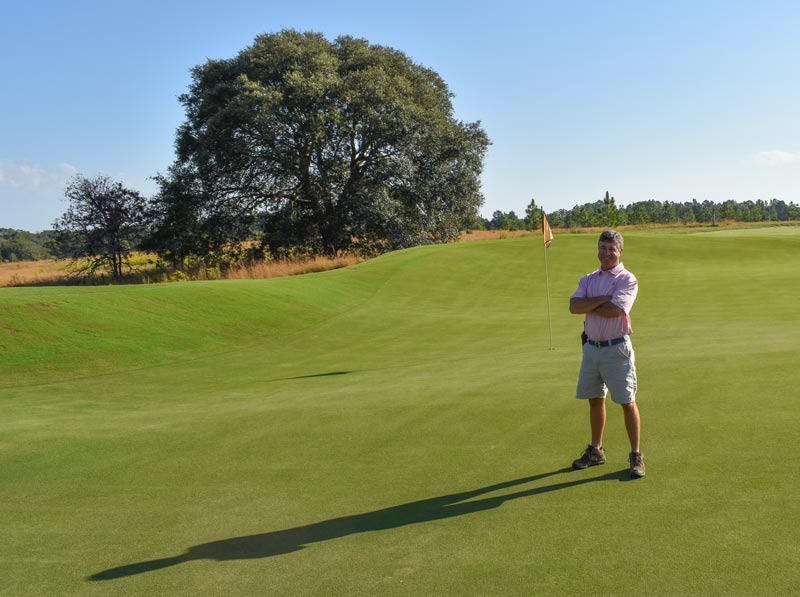
Superintendent Rhett Baker is pleased with how his TifEagle bermudagrass greens are performing on bases of straight sand mined on-site at Ohoopee Match Club in Cobbtown, Ga. Photos courtesy of Trent Bouts
Editor’s note: This article was originally published in the November/December 2018 issue of Through the Green, the official publication of the Georgia Golf Course Superintendents Association.
Rhett Baker is alive and well, yet finds himself in heaven anyway — on a good-for-nothing sea of sand, pretty much in the middle of nowhere.
Good for nothing, but great for a golf course.
And not just any course. Rather, the kind of course that Baker, a single-digit player well-read on the traditions of the game and its architecture, might have designed for himself ... in his wildest dreams.
Instead, Gil Hanse crafted Ohoopee Match Club, a high-end private facility in Cobbtown, Ga., with more than one twist, and greased the wheels that would eventually roll Baker into the job as golf course superintendent. The position opened a whole new dimension on a career that Baker, quite contentedly, believed had already peaked two hours north at venerable Palmetto Golf Club in Aiken, S.C.
Baker was at Palmetto, the Alister Mackenzie design that dates to 1892 and was a favored haunt of Bobby Jones before Augusta National, for 17 years. “Never thought I’d leave, to be honest with you,” the 23-year GCSAA member says. “But this has been awesome. It’s been a huge challenge and an incredible learning experience. It’s been a lot of fun. I’m in my early 50s; something like this is the kind of thing that keeps you going, keeps you moving and keeps you young.”
Ohoopee opened, quietly, as Georgia’s newest course in early October 2018. The absence of fanfare was entirely in keeping with the tenor of the club, developed by Long Island investor and entrepreneur Michael Walrath. It is nothing if not an escape — from northern winters, from the pace of high finance, essentially from anything other than golf and friends, maybe a couple dozen of whom will constitute the membership.
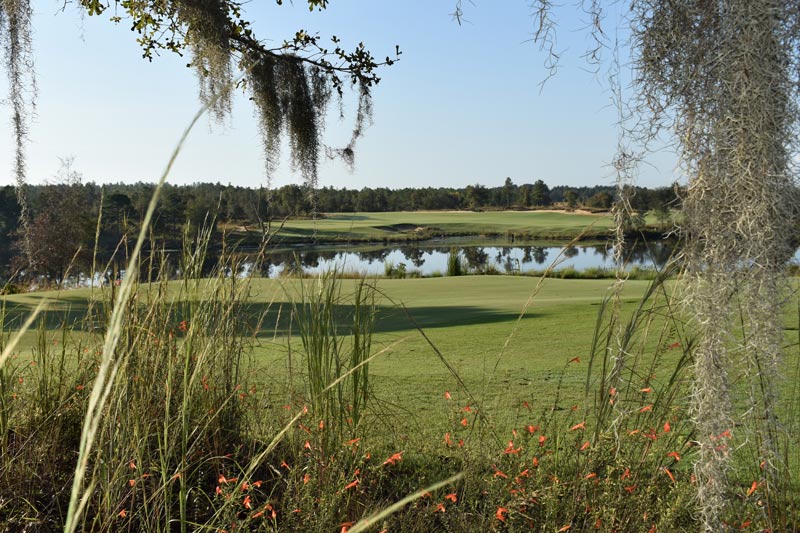
Serenity is easy to find at Ohoopee Match Club.
The course sits on more than 3,000 acres of rolling dunes, on the eastern, bottom land side of the Ohoopee River, a blackwater run that eventually finds its way to the Altamaha River in Tattnall County. The site is pure sand, deposited at the retreat of the ice age, which makes it tough going for a lot of flora. During construction, Baker’s crew cross-cut a pine barely 12 inches in diameter and were blown away by what they found.
“When we got to 75 rings — and we were only halfway through — we couldn’t count anymore because they were so close together,” he says. “It had to be a 110- or 120-year-old tree. All of the vegetation, it’s had to be pretty strong just to get to the point it is now. It’s the same things you’ll find in other parts of Georgia, but it grows differently; it acts differently. Vegetation-wise, there’s nothing that’s really happy out here. Because of the nutrition, it’s so low.”
Good for nothing ...
As Baker explains, others have tried to make something of the property so isolated it was said to be an aerial drop site for drug runners. For a time, it was a hunting preserve. Then there were plans for a hog farm until the small handful of neighbors put an end to that. “Then it was kind of a free-for-all,” Baker says. “All the locals would come out and go hunting. Then one of the onion farmers bought it, claiming it was Vidalia farmland. But he never planted anything.”
Next, and most ambitiously, came plans to create a self-contained motor-racing community with facilities for everything from moto-cross to Formula One, with several hundred high-end houses, a mini-airport, an equestrian center, hunting, fishing and two golf courses. Anticipated residents included the likes of actor John Travolta and country singer Alan Jackson.
Then came the crash of 2008, and the project, dubbed Victory Lane, was suddenly in pit lane and never coming out. The outline of the Formula One circuit, still clearly visible on Google Earth, is the only sign left that anything was more than talk.
That, and the fact that Hanse remembered the property. Along with Davis Love III, he’d been tapped to design one of the golf courses. And Hanse thought about it when, just a few years ago, Walrath asked him to look at a site near Albany. That property turned out to be heavy clay and dead flat, far from ideal when you’re looking to craft a course of interest, character and maintainability. Hanse suggested an alternative that, up to that point, had been largely good for nothing.
... but great for a golf course.
Baker had gotten to know Hanse when Hanse oversaw some tweaking at Palmetto beginning in 2003. Along the way, Hanse made small talk about the Victory Lane concept, which he explained was near Cobbtown, Ga. Baker, who attended Georgia Southern University in Statesboro, had never heard of Cobbtown, even though it sits just 30 miles southwest. When Victory Lane went belly up, Baker soon forgot about it again. But then, during a visit to Palmetto around the time of the 2016 Masters Tournament, Hanse told Baker, “Cobbtown’s back on again.”
“I said, ‘Well, that sounds great,’” Baker recalls. “I didn’t think much more of it. But later in the summer, I sent him an email. I said, ‘I’m never leaving Palmetto, but I’m curious about what’s going on.’” That September, in 2016, Jim Wagner, Hanse’s partner in the golf course building company, Caveman Construction, called and said, “Hey, we’re all going to Cobbtown. Why don’t you come and take a look at it?”

A field of goldenrod extends behind one of Ohoopee’s greens.
As a fan of Hanse’s work — as well as that of Tom Doak, Bill Coore and Ben Crenshaw, and “old architecture” in general — Baker jumped at the chance. Traipsing along with the group as Hanse staked out center lines in amongst the stunted woods, Baker was having a blast “just looking around.” Eventually, the party of about 20, which included Walrath and some friends partnering in the project, gathered at a hunting lodge on property for a lunch catered by the nearest restaurant available — Subway in Lyons, Ga., population 4,367.
“So, lunch turns into this, ‘Let’s quiz Rhett event,’” Baker grins. “For an hour, everybody was just quizzing me about everything under the sun — about the region, the climate, grasses, sand, you name it. I didn’t care. I was just there for a look. Soon after, they called and asked if I was interested in interviewing for the job.”
Baker couldn’t have been more ensconced at Palmetto. He loved the place and wasn’t looking to go anywhere. “Day in and day out, I liked to think we were as good a place as you’d find in this part of the country and I was happy about that, proud of that,” he says. But when the invitation came to go to Ohoopee, while holes were still being cleared, something shifted.
“I thought, ‘Well, how many new projects are there?” Baker says. “This never happens, where it’s to be this type of club and with the easygoing owner. All those things combined to make it kind of a no-brainer. I wasn’t really looking for a challenge, but I found I was up for one. And I got it.”
Hired at the end of November 2016, Baker started work early that December, and the challenge took shape immediately. He had about eight weeks to make a grassing selection, right when everything he might want to look at was dormant. In the back of his mind, Baker was leaning toward 419 bermudagrass for fairways and tees. The course was to have no rough. Instead, wide fairways would run to the edge of the hardscrabble vegetation that had been there all along.
Baker also pondered zoysiagrass, but was intrigued by TifTuf, the newest kid on the bermudagrass block. Developed at the University of Georgia, TifTuf was being touted for superior drought tolerance, a potential asset on a purely sand-based course. In addition to working the phones overtime, Baker was “driving all over the state talking to people and seeing what they had.”
The largest stand of TifTuf he could find was half of one fairway at Cherokee Town and Country Club in Atlanta. The other half was 419. “It was a pretty cold winter, so everything was 100 percent dormant,” Baker says. “And there was no noticeable difference between the two. So, I thought, ‘If that’s the worst it can look, it’s no worse than the 419.’”
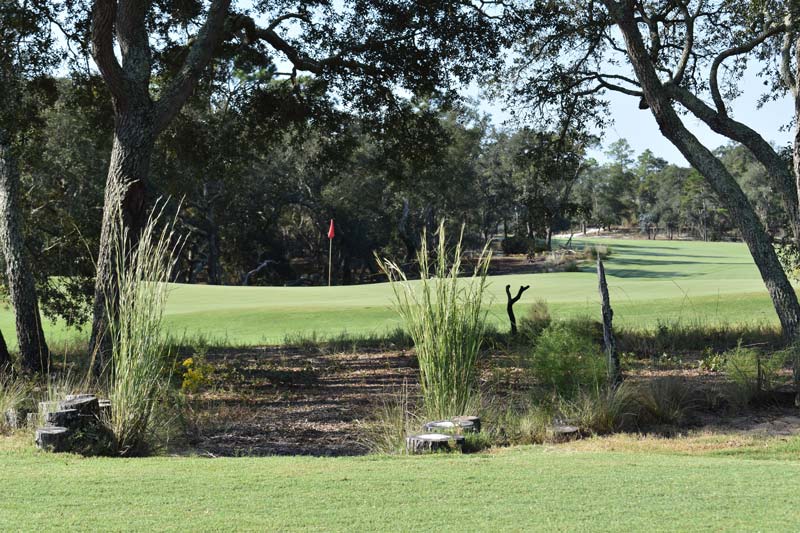
Branches stuck into the ground offer some direction to the next hole on a course with no signage at all.
He liked the look of Zorro zoysiagrass on the Creek Course at Reynolds Lake Oconee, but was concerned that there were no zoysia courses south of Reynolds. “It was a tough decision,” Baker says. “But it’s hard to go past bermudagrass in southeast Georgia.” TifTuf had something else going for it: a reported resilience to nematodes, which Baker knew — “with all this sand” — would be an issue.
Baker also spoke at length with Frank Rossi, Ph.D., from Cornell University, who also consults for Caveman Construction, but the tipping point probably came when the University of Georgia’s Brian Schwartz, Ph.D., who’d led a lot of the trials and research on TifTuf, told Baker point-blank, “Trust me, this grass is going to work for you.’”
The first delivery from Pike Creek Turf and NG Turf arrived in May of 2017. Baker didn’t even have a maintenance facility at that point. The first building of what stands now as a three-part facility didn’t open until that June. In between, Baker mowed those first 2 acres of his new TifTuf with a flymo. Today, he has close to 70 acres of TifTuf and another 4 acres of TifEagle greens.
“It seems to be a fairly aggressive grass, but it’s really hard to compare it with the 419 and others at this point,” Baker says. “When you’re talking about the quality of the turf, you have to factor in that we planted into straight sand. No organic matter whatsoever in any of this stuff. It’s hard to give the grass a fair evaluation because of that, but I can’t imagine anything doing any better than the TifTuf has.
“We’ve never gone backward with any of this turf. We’ve never had a situation where we thought this is not good. I thought that I might have to do something to introduce organics, but it looks like it might even be next year when we have to go to some reduction measures, some grooming, some verticutting. We have it where we want it right now, and we don’t want it to get any softer or thatchier. We’re also fortunate that we have an unlimited amount of topdressing sand, so we will be topdressing frequently, the entire course.”
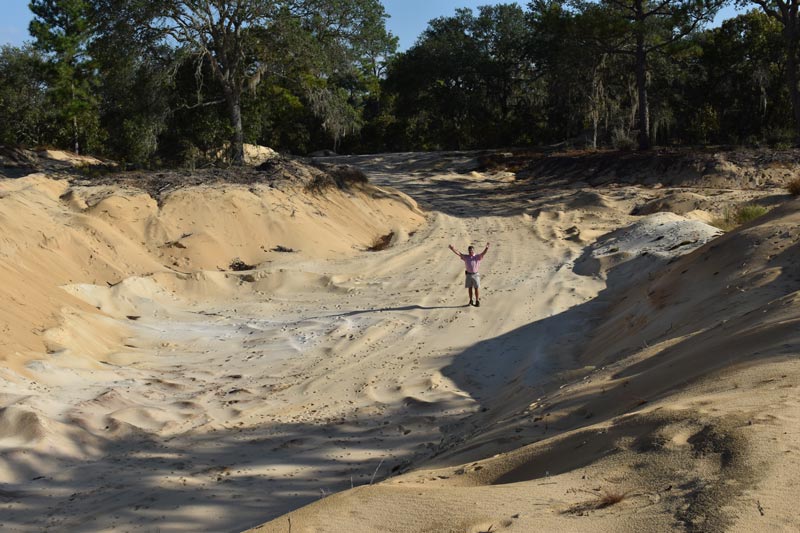
Baker in one of the three pits on the property that he can access for topdressing sand.
Baker has three major sand quarries on property, two of which, after a certain depth, produce “pure, straight sand, no seedheads, nothing.” “We just dig it out with a skid loader, put it in our topdresser and go spread it,” he says. “And it’s the exact same material the course was built on.”
The golf course itself was built quickly because so little earth was moved. For the most part, Baker says, a hole was cleared, then bulldozers smoothed — rather than shaped — what was left. The sole exception was one fairway that sits in a flood zone. It was elevated as much as 5 feet. The greens, all 22 of them, are push-ups. “We did run the top 18 inches through a screener, just to get any debris out,” Baker says. None have any subsurface drainage. In fact, there is no pipe, other than for irrigation, on the entire course.
The 22 greens come from the main 18-hole routing and a four-hole potential detour that allows, like much of the golf course, for a lot of flexibility serving the course’s primary design purpose as a match play facility. For the most part, tee boxes, which average about 80 yards in length and are not laser-leveled, will have no markers. The winner of the previous hole decides where the match tees off. There is a scorecard, but the attitude to the concept of par is whimsical, with four holes marked as par 4½. The whimsy continues with the extra holes, known simply as A, B, C and D.
“There’s such a variety out there,” Baker says. “You can play some holes as short par 5s or long par 4s. The 13th and 14th holes are a par 3 and a par 4, but they can just as easily be a par 4 and a par 3, or two par 3s, or two par 4s.”
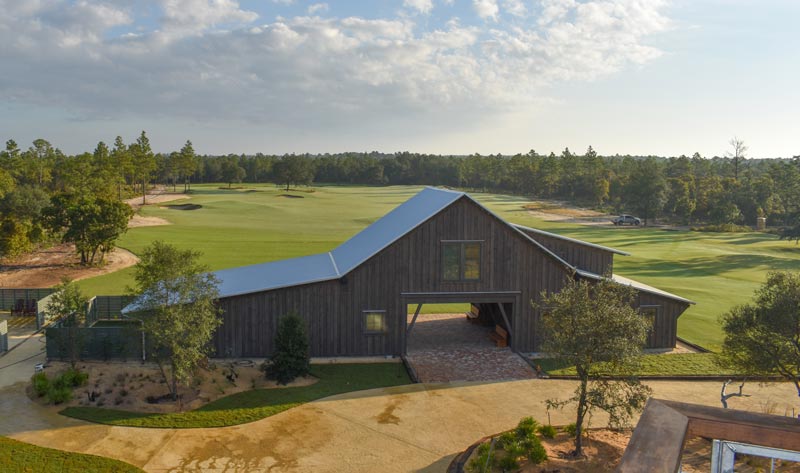
The barnlike pro shop at Ohoopee Match Club overlooks the driving range, which includes a nine-hole circuit known as “The Barefoot Nine.”
The walking-only course, with caddies, will open from “late September to late May-ish,” but with no overseeding, Baker expects it to be playable “just about any time.” “The membership has no care whatsoever about aesthetics, how green it is, how it looks,” he says. “They want firm and dry, and it’s easy to get it dry out here. I don’t know if any members will want to come down here in the summertime, but if they want to, they’ll be able to.”
When they do visit, they’ll stay in one of four barnlike structures, each with eight bedrooms, or perhaps in the pro shop building or clubhouse, which also offer lodging, all combined for up to 54 people. The rural architecture theme is understated and reflective of what Baker says is “a very easygoing membership. There aren’t really any rules or dress codes, no coat and ties. It’s a very laid-back place. It’s a place to come and relax.”
Baker cooks up a course and crew from scratch
Rhett Baker’s first office at Ohoopee Match Club was his truck. Corridors for two holes had been cleared, but that was all that existed. Just getting around on the property was a challenge. Paths needed a gravel layer to prevent vehicles from sinking into the sand.
“There were no utilities. I mean nothing,” Baker says. “You started everything from complete scratch. You fail to appreciate having a bin in your shop where you can get a nut and a bolt. The first piece of equipment we had, we lost a screw out of it, and it took an hour to drive to Lowe’s in Vidalia and come back.”
Baker may have seen more deer, turkey and bobcats than any of his superintendent colleagues during construction and grow-in, but he never felt alone after crossing the border from South Carolina. “I knew a lot of the guys in Georgia already, and they’ve been awesome,” he says, rattling off the names of those who have reached out or shared information, among them Patrick Reinhardt; Steve Collins; Berry Collett, CGCS; Lane Singleton; Greg Burleson, CGCS; Nelson Caron; Chris Steigelman, CGCS; and Tyson Helsel.
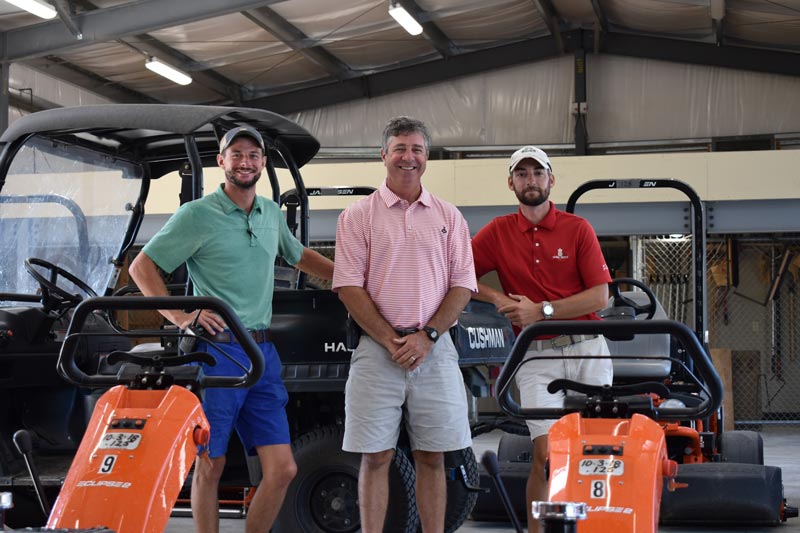
Baker (center) with assistant superintendents Jordan Gary (left) and Jonathan Suma.
On a day-to-day basis, though, Baker’s greatest allies have been first assistant Jordan Gary, who studied under Frank Rossi, Ph.D., at Cornell, and second assistant Jonathan Suma, who came to Ohoopee with no golf course management background at all. Gary had worked for Gil Hanse’s construction team for about a year before deciding that nomadic life wasn’t for him. “Jordan’s a really good find,” Baker says. “Strong, smart kid, great work ethic.”
Suma was working four 10-hour shifts at a Walmart distribution center in Vidalia when he walked onto Ohoopee looking to earn on the other three days in his week. A talented junior golfer, he thought he might land caddie work down the track. But Baker eyed him early on the construction crew, noting “a great eye for detail and a great work ethic.”
Gary and Suma are among 16 employees that Baker has settled on in a staff that, remarkably, only features one with previous golf course maintenance experience. “That’s a challenge in itself,” he says. “But you try to think long term. They’re going to learn the way you want them to learn, and so far, it’s been really good.”
Today, Baker’s team works out of an impressive facility that makes those early days working out of his truck hard to imagine. Baker had drawn up his own plans for how the facility might look, but then he met the architect. “He unrolled his design and said, ‘Well, this is what I’ve got.’ I took my design, wadded it up and threw it in the trash,” Baker says. “I told him, ‘I like yours way better.’”
The one asterisk on the facility, though, is that, in order to maintain the quiet ambiance for golfers, it sits three-quarters of a mile from the golf course. “You need to think well ahead about what you’ll need when you get out there,” Baker smiles.
Trent Bouts is a freelance writer and the editor of several superintendent association magazines, including Through the Green for the Georgia Golf Course Superintendents Association.